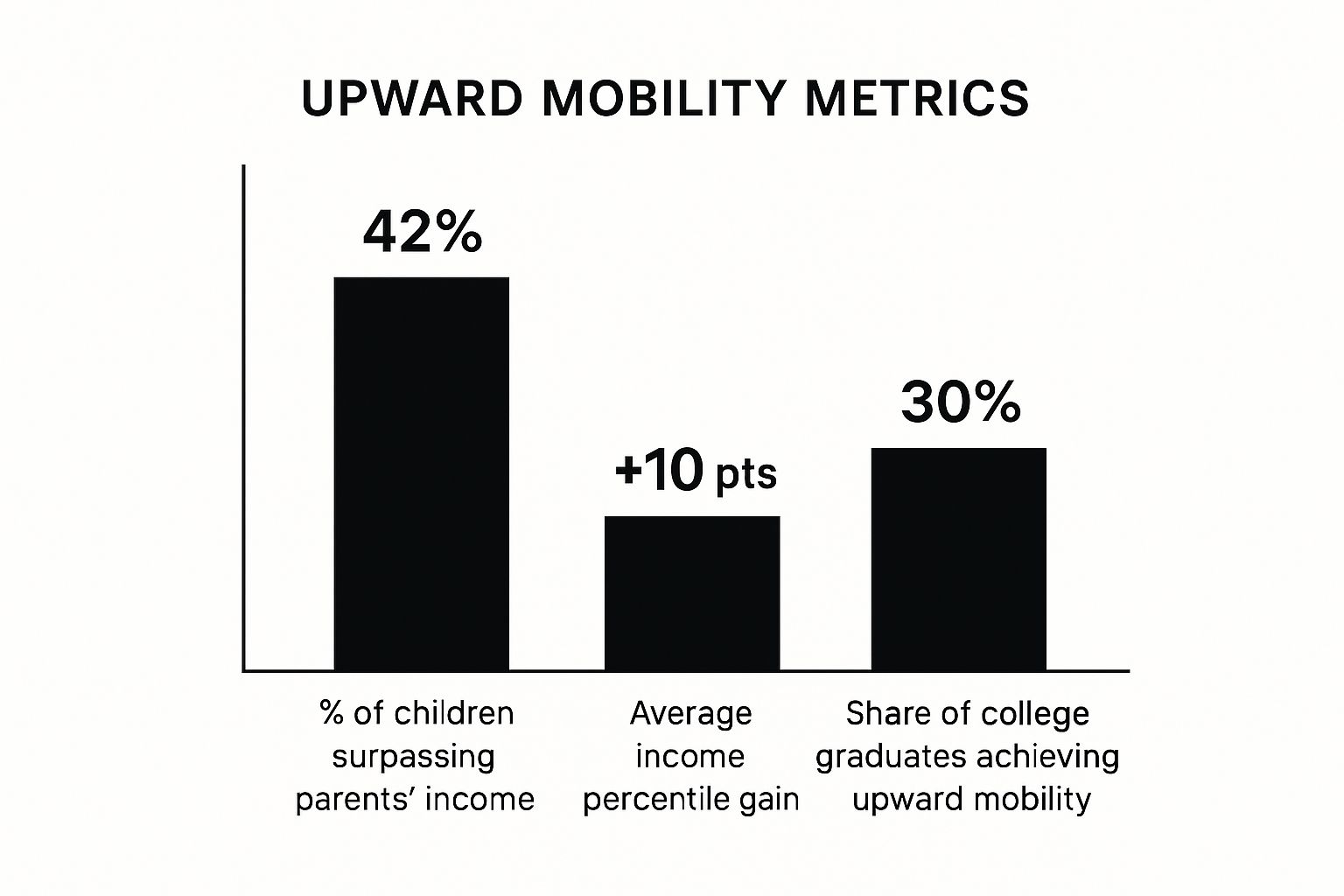Master Upward Mobility in India: Proven Growth Strategies
Understanding India’s Upward Mobility Reality Check

The infographic above illustrates three crucial metrics related to upward mobility: the percentage of children earning more than their parents, the average increase in income percentile, and the proportion of college graduates experiencing upward mobility. The data paints a complex picture. While a significant 42% of children are out-earning their parents, a positive indicator of intergenerational mobility, only 30% of college graduates are moving up the economic ladder. This suggests that education, while important, isn’t the sole determinant of economic progress. The average income percentile gain of +10 points further highlights the incremental nature of upward mobility in India.
Upward mobility in India is a multifaceted issue, showing significant regional variations. States like Tamil Nadu and Kerala often exhibit better upward mobility outcomes compared to other states. This is likely attributed to a combination of factors, including better educational infrastructure and more robust job markets.
Understanding where the real opportunities lie is key to navigating this complex landscape. The disparity between urban and rural areas adds another layer of complexity to the upward mobility equation. Urban areas typically offer more diverse career paths.
Regional Disparities and the Urban-Rural Divide
The urban-rural divide significantly shapes upward mobility trajectories. Urban centers, with their concentrated industries and educational institutions, generally offer more avenues for advancement. This concentration, however, also leads to increased competition.
Individuals in rural areas often face limited opportunities, sometimes necessitating migration to urban areas in search of better prospects. These regional disparities underscore the need for targeted interventions to bridge the gap and create more equitable opportunities throughout India.
The Influence of Education and Employment
Access to quality education is a fundamental driver of upward mobility. A well-rounded education equips individuals with the skills and knowledge they need to compete in the job market and advance economically. Proficiency in in-demand skills, for instance, can greatly improve employability and earning potential.
The evolving job market, with the rise of new industries and technologies, presents both challenges and opportunities for upward mobility. Adaptability and continuous learning are crucial for individuals to remain competitive and progress in their careers.
To better understand the regional variations in upward mobility, let’s look at the following table:
Regional Comparison of Upward Mobility Opportunities
| Region | Education Access Score | Employment Opportunities | Infrastructure Quality | Mobility Rating |
|---|---|---|---|---|
| Tamil Nadu | 85 | High | 75 | 80 |
| Kerala | 90 | Medium | 80 | 85 |
| Maharashtra | 70 | High | 85 | 75 |
| Bihar | 50 | Low | 40 | 45 |
| Uttar Pradesh | 55 | Medium | 45 | 50 |
This table presents a simplified representation of regional upward mobility factors based on general observations and is not derived from specific statistical data.
As the table illustrates, states with better access to education and more employment opportunities tend to have higher mobility ratings. This reinforces the importance of investing in these areas to improve overall upward mobility.
India’s overall upward mobility, specifically its Social Mobility Index, is relatively low globally, scoring 42.7 out of 100 according to recent assessments. This puts India on par with countries like South Africa and Bangladesh, marking it as one of the lowest performers among developing economies. For comparison, Nordic nations like Denmark lead with a score of 85.2. This significant gap highlights the need to address systemic challenges and create pathways for greater economic mobility. More detailed statistics can be found here.
Breaking The Income Persistence Trap That Holds You Back

Upward mobility in India remains a significant challenge. Many families find their income stagnant across generations, limiting opportunities and creating a sense of being trapped. Understanding the factors at play is the first step toward achieving financial progress.
One key factor is occupational mobility, or the ability to move into different professions. Children often follow in their parents’ footsteps, perpetuating the income cycle. Fewer than one in ten children from low-income families in India are likely to reach the top income quintile as adults.
Recent analyses highlight this income stagnation and limited occupational mobility as a defining characteristic of the Indian economy. The World Economic Forum’s Social Mobility Index ranks India 76th out of 82 countries, underscoring the difficulty in providing equal opportunities. Learn more about the factors contributing to this ranking here.
Disrupting Generational Patterns
Despite the challenges, stories of individuals breaking through these barriers offer hope and valuable lessons. Examining these success stories reveals common strategies, such as prioritizing skill development and continuous learning to adapt to the job market’s evolving needs. For further insights on skill development, explore the India Skills Reports.
Building a strong professional network and seeking mentorship also provide essential guidance and access to new opportunities. These proactive steps can help individuals navigate the complex factors influencing upward mobility, from education access to employment market dynamics.
Policy Impacts and Affirmative Action
Government policies significantly impact upward mobility. Affirmative action policies have created opportunities for some groups, while others continue to face persistent obstacles. Understanding how these policies affect individual circumstances is vital for developing an effective strategy.
This involves assessing your current situation, recognizing potential roadblocks, and utilizing available resources to overcome them. This proactive approach empowers individuals to control their career paths, break free from generational limitations, and create a future where income is no longer predetermined.
Skills Over Credentials: Your New Upward Mobility Advantage
The hiring landscape in India is transforming. Companies are increasingly prioritizing skills over traditional credentials, creating exciting opportunities for upward mobility, especially for talented individuals from Tier 2 cities and those with non-elite educational backgrounds. This shift offers a significant advantage for those who adapt and showcase their abilities effectively.
Showcasing Your Skills: Beyond Degrees and Pedigrees
This evolving job market prioritizes demonstrable skills and practical experience over prestigious degrees. Your ability to perform specific tasks and solve real-world problems is now more valuable than where you studied or your family background. For example, strong coding skills and demonstrable project experience can be more attractive to employers than a degree from a well-known university when applying for software development roles. Want to learn more? Check out this resource: How to master the new job market and build a career you love.
Having practical experience is increasingly important.
Remote Work: Expanding Opportunities for All
The growth of remote work has leveled the playing field, enabling individuals from anywhere in India, including Tier 2 cities, to compete for jobs that were once geographically restricted. This also creates a more diverse and inclusive talent pool for companies. Remote work can reduce the financial burden of relocating, making upward mobility more accessible.
More and more companies are embracing remote work options.
A study by Michael Page India and the Centre for Economics and Business Research (Cebr) highlights the importance of recognizing talent beyond traditional metrics. The research indicates that improving India’s Social Mobility Index by just two points could add over 5.2 million people to the workforce and potentially Rs 2.7 trillion to the GDP. This growth is possible because many talented individuals are often overlooked due to biases. Learn more about these important statistics here.
This study underscores the economic benefits of inclusivity.
To help visualize the shift in hiring practices, let’s look at a comparison table:
Traditional vs Skills-Based Career Advancement
Comparison of old hiring practices versus new skills-focused approaches and their impact on mobility
| Factor | Traditional Approach | Skills-Based Approach | Mobility Impact | Success Rate |
|---|---|---|---|---|
| Emphasis | Pedigree, Institution | Demonstrable Skills, Experience | Increased | Higher for skilled individuals |
| Location | Often limited by geography | Remote opportunities expand reach | Significantly Improved | Increased for those in Tier 2 cities |
| Bias | Prone to biases | Reduces impact of bias | Positive | Increased for non-traditional backgrounds |
| Measurement | Degrees, Titles | Portfolio, Projects, Contributions | More Accurate | More meritocratic |
This table illustrates how a skills-based approach broadens access to opportunities and promotes a more equitable system for career advancement. By focusing on skills, companies can tap into a wider pool of talent and individuals can chart their own career paths based on merit.
Navigating the Shift: Strategies for Success
To thrive in this skills-based environment, develop a targeted strategy for showcasing your abilities. This includes building a strong online presence that highlights your skills and accomplishments.
Consider these strategies:
- Create a portfolio of your work
- Contribute to open-source projects
- Participate in online coding challenges
Networking, both online and offline, can help you access new opportunities and gain industry insights.
Breaking Through Hiring Biases
While the shift toward skills-based hiring is positive, biases can still exist. By proactively showcasing your capabilities and building a strong professional network, you can overcome these challenges. Focus on demonstrating the value you bring through tangible examples of your accomplishments and contributions. Let your skills and experience speak for themselves. This empowers you to take control of your career and unlock your full potential.
Building Your Personal Upward Mobility Blueprint

Let’s transform these ideas into a personalized action plan for your own upward mobility. This blueprint will guide you in evaluating your current situation and creating a practical path forward, specific to your individual needs. This goes beyond simply having big dreams; it requires strategic planning and consistent effort.
Assessing Your Current Position: Knowing Your Starting Point
Before mapping out your journey, it’s crucial to understand your current standing. This requires a realistic self-assessment of your skills, qualifications, experience, and current income. For example, list your existing skills and compare them to those in demand on job portals like Talent Hired. This self-awareness is the foundation for identifying growth areas and setting achievable goals.
Also, think about your current network and available resources. Are there mentorship programs you can join? Do you have access to professional development opportunities? Identifying these resources is essential preparation for your journey.
Charting Your Path: Skills, Networks, and Opportunities
With a solid understanding of where you stand, you can begin to craft a roadmap tailored to your goals. Concentrate on acquiring in-demand skills relevant to growing industries. Data science, artificial intelligence, and digital marketing are examples of fields currently experiencing high demand in the Indian job market. This proactive approach will open doors to better opportunities.
Networking is another key element of upward mobility. Cultivate connections within your industry and beyond. Attend industry events, join professional organizations, and participate in online communities relevant to your field. In India, building relationships and leveraging your network can significantly influence career advancement.
In addition, learn to recognize emerging opportunities before they become saturated. This involves staying informed about industry trends, following thought leaders, and researching new sectors. By anticipating future demands, you can position yourself at the forefront of innovation.
Leveraging Resources for Accelerated Growth
Strategically use resources that can boost your career progression. Online learning platforms offer numerous courses and certifications to enhance your skillset. Take advantage of continuous learning to stay ahead of the curve.
Professional mentorship can offer invaluable guidance and support. A mentor can share insights from their experiences, help you navigate challenges, and connect you with new opportunities. Finding the right mentor can be transformative for your upward mobility.
Overcoming Obstacles: Navigating Challenges
The path to upward mobility isnât always easy. Be prepared for challenges such as geographic limitations, educational gaps, and potential industry biases. These obstacles, however, can be overcome.
Remote work opportunities are expanding access to a broader range of jobs, especially for those in Tier 2 cities. Bridge educational gaps through online certifications or part-time courses. Counter industry biases by building a strong portfolio and showcasing your accomplishments. By proactively addressing these challenges, you can create a smoother path to success.
Real-World Examples: Inspiration and Guidance
Real-life success stories can offer valuable inspiration and practical advice. Research individuals who have achieved significant upward mobility in India. Learn from their strategies, experiences, and adapt their approaches to your own situation.
These stories often emphasize the importance of perseverance, adaptability, and a growth mindset. Remember, upward mobility is a continuous journey. By embracing these principles and consistently implementing your personalized blueprint, you can achieve meaningful progress toward your career goals and build a more rewarding future.
Leveraging Economic Shifts For Career Acceleration
India’s economic landscape presents a dynamic mix of challenges and opportunities. For professionals seeking upward mobility, understanding and capitalizing on these shifts is key. Aligning your career strategy with emerging trends can significantly accelerate your growth.
Riding the Wave of Government Initiatives
Government initiatives significantly influence economic development and career opportunities. Programs focused on skill development and infrastructure investment create new avenues for advancement. For instance, initiatives promoting digital literacy and technology adoption, such as the Digital India Programme, open doors to the expanding IT sector. Staying informed about these programs and aligning your skills accordingly can be a powerful strategy. Furthermore, government support for entrepreneurship and startups cultivates innovation, generating new pathways for career growth and wealth creation. Sectoral reports and analyses can help identify these emerging trends: Sectoral reports and analyses that can help identify emerging trends.
The Startup Surge: New Opportunities
India’s thriving startup ecosystem presents exciting opportunities. Startups often prioritize skills and experience over traditional credentials, offering a platform for talented individuals. This fast-paced environment fosters rapid skill development and career progression. The flexibility in roles and responsibilities within startups allows you to showcase versatility and adaptability. For example, strong technical skills can lead to rewarding opportunities in fintech or edtech startups, even without extensive sector-specific experience. The dynamic, learning-oriented startup culture further accelerates professional development.
Evolving Corporate Practices: Adapting to Change
Established corporations are also adapting, creating new avenues for upward mobility. The adoption of skills-based hiring recognizes the value of diverse talent pools. This shift allows individuals from non-traditional backgrounds to advance based on abilities, not just educational credentials. The rise of remote work expands access to opportunities across geographies. Individuals in Tier 2 cities can now compete for roles in major metropolitan areas without relocating. This broader reach creates a more inclusive and competitive talent market, driving upward mobility for those who adapt.
Positioning for Success in a Changing Economy
To effectively leverage these shifts, consider the following:
- Identify Emerging Sectors: Research high-growth sectors and align your skills with their demands.
- Policy Awareness: Stay informed about government policies and initiatives that can benefit your career.
- Networking: Build connections within your industry and emerging sectors to access new opportunities.
- Continuous Learning: Invest in developing relevant skills to remain competitive.
By understanding the interplay of government initiatives, startup growth, and corporate changes, you can develop a proactive career strategy. This approach empowers you to navigate the evolving economic landscape and unlock your full potential for upward mobility in India.
Overcoming Systemic Barriers That Block Progress

Upward mobility in India isn’t solely about individual effort. It requires navigating a complex network of systemic barriers, ranging from ingrained societal structures to biases in hiring. This section explores these challenges, offering practical solutions for achieving upward mobility despite these hurdles.
Addressing Caste and Regional Disparities
Caste and regional disparities have historically limited access to opportunities. However, strategic actions can help individuals overcome these challenges. Supporting organizations dedicated to social equity and empowerment offers valuable resources and direction.
Initiatives promoting education and skill development within marginalized communities can equip individuals with the necessary tools for advancement. Building a strong professional network can also bridge these gaps, connecting individuals with mentors and peers from diverse backgrounds, opening doors to new opportunities and providing valuable support.
Overcoming Gender-Based Limitations
Gender-based limitations remain a significant barrier to upward mobility for many women in India. A comprehensive approach is needed to address this complex issue. Promoting women’s education and skill development is crucial, empowering them to pursue their career goals.
Organizations dedicated to women’s empowerment frequently offer mentorship programs and networking opportunities, helping women overcome traditional barriers. Advocating for policies that support work-life balance and equal pay is also essential, fostering a more equitable professional environment.
Building Resilience and Pushing for Change
Navigating systemic barriers demands resilience and a proactive approach. Developing coping mechanisms for setbacks and challenges is essential. Support networks, whether through family, friends, or professional organizations, can provide crucial emotional and practical assistance.
Working effectively within existing systems while advocating for positive change is a powerful combination. Promoting policies that advance equal opportunities and challenging discriminatory practices can create a more just and equitable society.
Practical Strategies for Overcoming Barriers
Building a strong support network is vital for success. Here are some actionable steps:
- Identify relevant organizations: Research groups focused on your community or the barriers you face.
- Network strategically: Connect with people from diverse backgrounds and build mentor relationships for guidance.
- Seek out mentorship programs: Many organizations offer programs tailored to specific needs, such as women in tech or entrepreneurs from marginalized communities.
- Develop a strong support system: Cultivate relationships with family, friends, and colleagues for emotional and practical support.
By implementing these strategies and cultivating a strong support system, individuals can navigate systemic barriers and forge a path toward lasting upward mobility. Achieving upward mobility in the face of these challenges is an ongoing journey. By focusing on your goals, building resilience, and advocating for positive change, you can create a brighter future for yourself and contribute to a more equitable society.
Your Action Plan For Sustainable Upward Mobility
This section offers a practical roadmap for your upward mobility journey. We’ll combine the strategies discussed into a concrete plan with achievable milestones, clear metrics, and adaptable strategies. This plan isn’t about overnight success; itâs about building long-term career resilience.
Creating Your Personalized Roadmap
Building a roadmap starts with setting SMART goals: Specific, Measurable, Achievable, Relevant, and Time-bound. For example, instead of “get a better job,” aim for a specific role, desired salary, and timeline. Perhaps your goal is to become a Senior Data Analyst with a 20% salary increase within two years.
Next, break down your goals into smaller, manageable steps. If upskilling is necessary, set monthly milestones for learning. If networking is key, aim to connect with a certain number of professionals each week. This structured approach paves the way for achieving your long-term objectives.
| Goal | Milestone 1 | Milestone 2 | Milestone 3 |
|---|---|---|---|
| Become a Senior Data Analyst | Complete a Data Analytics certification | Build a portfolio of data analysis projects | Network with 10 professionals in data science |
Measuring Your Progress and Adapting to Change
Define Key Performance Indicators (KPIs) to objectively track your progress. These might include completing certifications, salary increases, promotions, or acquiring new skills. Regularly review your KPIs and adapt your plan as needed.
For instance, if networking isn’t yielding results, reassess your approach. Consider exploring different online communities or attending industry events. This iterative process keeps you moving toward your goals.
Staying Motivated and Building Resilience
The upward mobility journey isn’t always easy. Setbacks happen, but maintaining momentum and resilience is crucial. Celebrate your wins, big or small, to reinforce positive progress. View failures as learning opportunities, analyze what happened, adjust your strategy, and keep going.
A strong support system can also make a difference. Surround yourself with family, friends, or mentors who encourage your growth.
Practical Checklists and Timeline Suggestions
- Short-term (3-6 months): Update your CV and online profiles like LinkedIn, identify skill gaps, and start networking.
- Mid-term (6-12 months): Enroll in upskilling courses, build your portfolio, and actively apply for targeted roles.
- Long-term (1-2 years): Achieve desired certifications, gain relevant experience, and secure a position aligned with your upward mobility goals.
These timelines are flexible and should be adapted to your individual situation and goals.
Remember, this is your personal journey. Celebrate successes, learn from setbacks, and adapt your strategy as new opportunities arise. Sustainable upward mobility requires consistent effort, a proactive approach, and the right mindset.
Ready to take control of your career and accelerate your upward mobility? Visit Taggd to explore job opportunities and resources.
